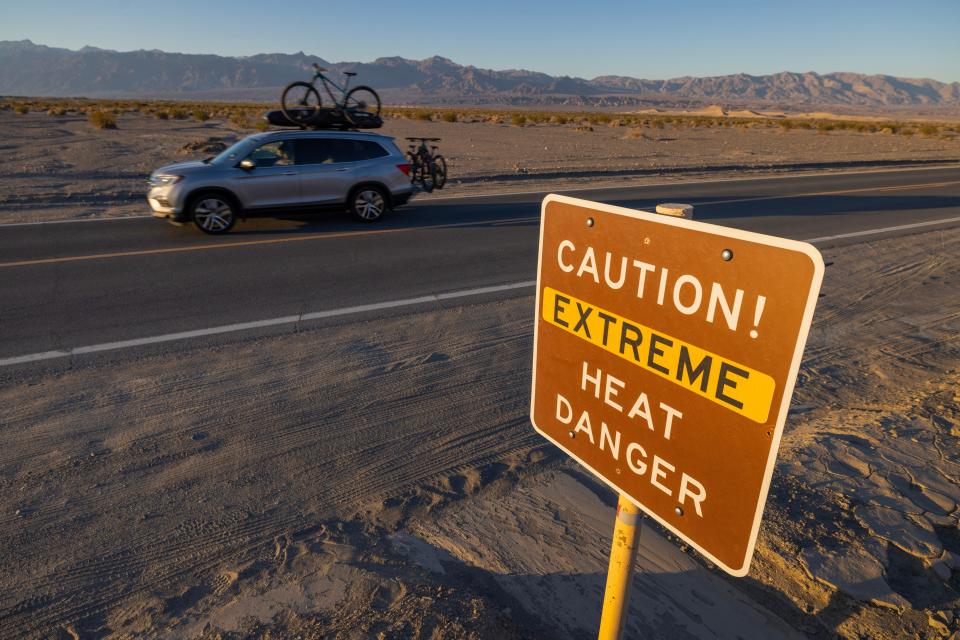First heat wave to scorch the West because of a 'heat dome.' Who will see extreme temps?
The USA's first major heat wave of the summer will overspread the West over the next few days, forecasters said, pushing temperatures to dangerous and even "life-threatening" levels across several states, including California, Nevada and Arizona.
By later this week, temperatures in Phoenix and Las Vegas could reach 111 degrees, the National Weather Service said. Many record highs are possible.
Notorious hot spot Death Valley, California, could reach 124 degrees by the end of the week, which would be a record warm temperature for this early in the year.
Excessive heat warning in effect
In Phoenix, where an excessive heat warning was in effect, the National Weather Service warned that "extreme heat will significantly increase the potential for heat-related illnesses, particularly for those working or participating in outdoor activities."
Little overnight relief will make for dangerous conditions for those without effective cooling or adequate hydration, the weather service said.
Forecasters and local officials are urging residents to stay in air-conditioned areas, drink plenty of fluids and check on neighbors and relatives.
"Extreme heat is an invisible but dangerous consequence of climate change, and CA's outdoor workers, seniors + children are particularly vulnerable," California's Environmental Protection Agency said in a social media post.
To put this early heat in context, the high temperature forecast for Las Vegas on Thursday is 111 degrees, the weather service in Las Vegas said. That would tie the earliest 111-degree reading in Las Vegas on record.
Wildfires ignite in California as heat builds
Wildfires ignited in California over the weekend as the heat began to build. Hundreds of emergency responders on Monday continued battling a 14,000-acre wildfire east of San Francisco that has injured two firefighters and triggered evacuations ahead of high temperatures forecast for this week.
“The Corral Fire has become the first 10,000-acre fire this year in California,” said AccuWeather meteorologist Brandon Buckingham. “Given the heat, dryness, and sunshine this week, there will likely be more fires breaking out that can quickly spread.”
The National Weather Service warned excessive heat will bear down this week across a vast stretch of central California, including the San Joaquin Valley. The advisory, which will be in effect from 11 a.m. Tuesday to 8 p.m. Thursday, warns of "dangerous hot conditions." Temperatures of 95 to 108 degrees are possible.
'Heat dome' over Mexico heads north
The coming heat in the western U.S. is partly related to a heat wave that has been scorching Mexico the past few weeks, leading to dozens of deaths. The extreme heat in Mexico is the result of a strong "heat dome" of high pressure that's slowly nudging its way north into the western U.S.
A heat dome is "a bubble of high pressure and warm air that suppresses clouds and rain and diverts the storm track well to the north," Weather.com meteorologist Jonathan Erdman said. "When those happen in the heart of summer, they can lead to extended heat waves near their core."

How should you prepare for extreme heat?
As extreme heat and humidity can challenge the body's ability to cool itself, it is valuable to know the signs of excessive heat exposure and how to treat heat-related illnesses. Knowing the warning signs for heat stroke and heat exhaustion, and the differences between the two, can help you to protect yourself and those around you, experts say.
Those at greatest risk of heat illness are people 65 or older or children under 2, plus those living with chronic diseases or mental illness, according to the Centers for Disease Control and Prevention.
People can prevent heat-related illness by drinking water, using air conditioning, limiting outdoor activity, spending time in the shade when outside, and cooling off in a pool or other body of water.
Contributing: Christopher Cann and Cady Stanton, USA TODAY; Reuters
This article originally appeared on USA TODAY: 2024's first heat wave to scorch California, West: Here's the forecast


